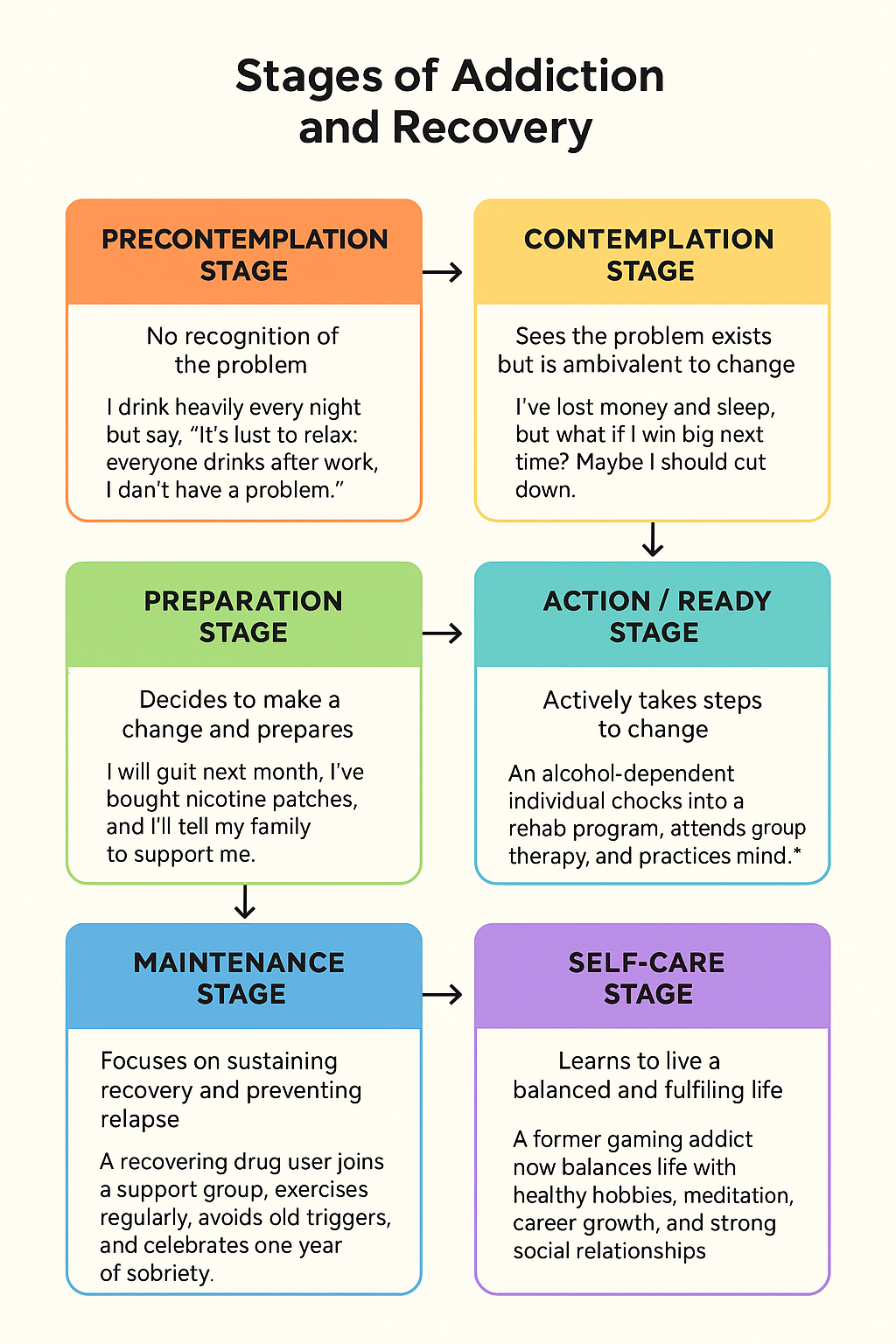Addiction isn’t a switch that gets flipped from “using” to “stopped.” It’s a journey—a winding path with hills and valleys, moments of incredible strength, and times of profound challenge. Understanding the stages of this journey isn’t about labeling; it’s about offering a map. It helps individuals and their loved ones see where they are, what’s ahead, and, most importantly, that they are not lost.
Recovery is not a linear process. It’s common to move back and forth between stages, and that’s okay. A relapse isn’t a failure; it’s a sign that a different approach or more support is needed. Let’s walk through these stages together.
1. The Unseeing Stage (Precontemplation)
What it feels like: In this stage, the person doesn’t believe their behavior is a problem. If a friend or family member voices concern, they might meet it with defensiveness, denial, or even anger. From the outside, it can be incredibly frustrating. From the inside, it’s a protective mechanism—a way to avoid the terrifying thought that life might have to change.
The inner voice: “I can quit anytime I want, I just don’t want to.” or “Everyone drinks this much; it’s just how we unwind.”
How to help: Confrontation often backfires. Instead, express concern with “I” statements (“I feel worried when I see you in pain”) and offer information without pressure. Plant a seed, don’t try to force a tree to grow.
2. The Wavering Stage (Contemplation)
What it feels like: This is the stage of ambivalence. The person can now see the negative consequences—the strained relationships, the health issues, the financial stress—but the perceived benefits of the substance or behavior still hold power. It’s an internal tug-of-war between the desire to change and the fear of what that change entails.
The inner voice: “I know this is hurting me, but what will I do without it? How will I cope with stress? Will I even have any friends left?”
How to help: Listen without judgment. Help them explore the pros and cons of their behavior themselves. Ask open-ended questions: “What would your life look like if you changed?” Your role is to be a sounding board, not a debater.
3. The Preparing Stage (Preparation)
What it feels like: A decision has been made. There’s a flicker of hope and determination. The person is getting ready to take action, often within the next month. This stage is filled with small, practical steps—researching rehab options, telling a loved one they need support, or setting a quit date.
The inner voice: “Okay, I’m going to do this. I’ve called a treatment center for information. I need to clear my schedule for next month.”
How to help: This is a time for practical and emotional support. Help them research options, celebrate their decision, and reinforce their commitment. Your belief in them can fuel their courage.
4. The Doing Stage (Action)
What it feels like: This is the stage of visible change. The person actively modifies their behavior, often with professional help. They may enter a detox program, start therapy, or begin attending support group meetings. This stage requires immense effort and is often where withdrawal and intense cravings are faced head-on. It’s both empowering and vulnerable.
This is where the structured support of a rehabilitation center becomes critical. A rehab environment provides a safe space to navigate the hardest parts of early recovery with medical and psychological support readily available.
The inner voice: “It’s hard, but I’m going to my therapy session today. I used my coping skills when a craving hit.”
How to help: Offer unwavering encouragement. Recognize the enormous effort they are putting in. Be patient, as mood swings are common. Practical help, like assisting with responsibilities while they focus on recovery, is invaluable.
5. The Sustaining Stage (Maintenance)
Definition: This is the long-term work of sustaining recovery and building a new, sober life. It’s about more than just avoiding relapse; it’s about actively creating a lifestyle where relapse is less likely. This involves integrating new coping strategies, managing triggers, and building healthy routines.
Why the Maintenance Stage is a Key Time to Be in Rehabilitation:
While the Action stage is about initiating change, the Maintenance stage is about solidifying it. Many high-quality rehabilitation programs are designed to guide individuals through this crucial phase. Staying in a rehab center during early maintenance provides:
A Safe Environment: It allows individuals to practice new skills in a controlled setting before facing the complexities of their everyday environment.
Continued Therapy: Deep-rooted psychological patterns are addressed through ongoing individual and group therapy.
Relapse Prevention Planning: Specialists help create personalized plans to identify and manage triggers, warning signs, and high-risk situations.
Community Building: Living with others on the same journey reduces isolation and builds a powerful support network.
What it feels like: This is the “new normal.” The person is living their recovery plan, attending ongoing support meetings, and has learned to navigate life’s ups and downs without returning to old habits.
The inner voice: “I faced a huge trigger today and got through it by calling my sponsor and going for a run. I’m proud of myself.”
How to help: Celebrate milestones (30 days, 90 days, one year!). Continue to be a supportive listener. Engage in healthy activities together that reinforce their new lifestyle.
6. The Thriving Stage (Self-Care & Transcendence)
What it feels like: Recovery evolves from a primary focus on “not using” to a focus on overall well-being and purpose. The person isn’t just surviving without their addiction; they are thriving because of the lessons learned in recovery. They have a toolbox of self-care practices for their physical, mental, and emotional health.
The inner voice: “My past struggle with addiction is a part of my story, but it doesn’t define me. I now have healthy relationships, hobbies I love, and tools to take care of myself.”
How to help: Encourage their growth and new interests. See them for the whole person they have become, not just someone “in recovery.”


Leave a Reply